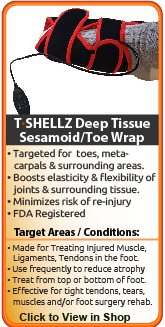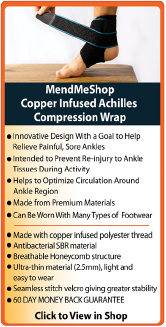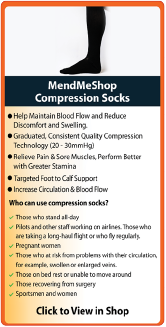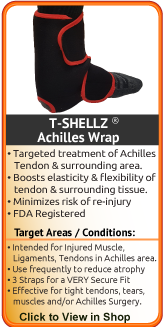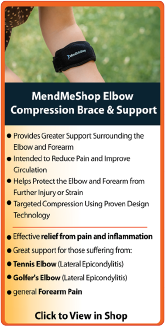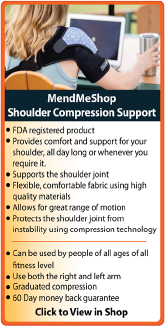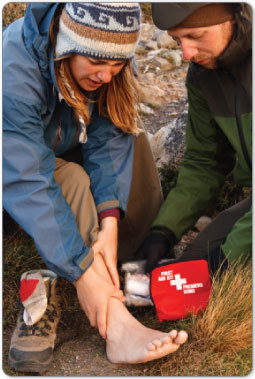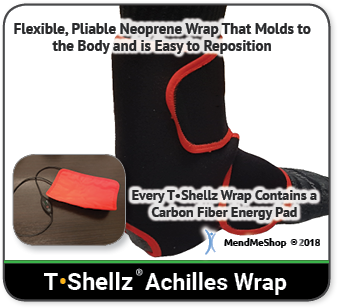Ice vs Heat for Treating Your
Achilles Tendon Injury
When dealing with an Achilles tendon injury it's hard to know what treatment will work best for you. You might be wondering if ice and heat are applicable... Or maybe even which will work better - ice OR heat.
Icing and heating are 2 of the most natural treatment options available. Compared to medications, surgery and other treatment methods - icing and heating have been around for centuries and have always been used for ankle injuries as a means to soothe and heal.
We understand that it can get pretty confusing to figure out what conservative treatment method will work best with all of the treatment options available to you today. To get started, you should think about the benefits you'll get from using these therapies.
What's Better to Treat Your Achilles: Ice or Heat?
Ice and heat are the best treatment combination for you if:
- You're looking to boost the natural power of pain relief and healing in your body.
- You don't want to repeatedly pay the cost (both from your wallet and time needed for long-term healing) of injections, medications, hospital visits or surgery.
- You want to help reduce the risk of re-injury, pain or swelling in your Achilles tendon.
- You want to reduce the risk of worsening the injury.
- You want to control your own treatment and recovery at home, on your own time.
- You're looking for a tried and tested method of healing that has worked for countless other achilles pain sufferers.
Combining cold and warmth is a simple yet effective way to get immediate pain relief and promote long-term healing. In your lifetime you've probably had your mom, family doctor, nurse, surgeon or physical therapist tell you to use ice right after you're injured and something warm from time to time once the swelling's gone down. It's a simple yet very effective way to relieve pain and promote healing in your Achilles.
Achilles tendon injuries can happen to anyone, right now there are thousands of doctors and physical therapists dealing with patients that require a solution to their soft tissue injury fast and heal it (where possible).
If you want to be proactive about properly dealing with your achilles pain, speak to your doctor about adding conservative temperature treatments to your recovery with AidMyAchilles's system using a Cold Compress or Ice Pack and Circulation Boost with a Achilles TShellz Wrap®.
Note: If you have an Acute (recent, inflamed) Soft Tissue Injury, Do Not Use Heat.
Your doctor knows that the sooner cold is applied, the quicker you can reduce inflammation and achieve real pain relief. This will help reduce the chance of a much longer lasting chronic injury. Heat and inflammation are a bad mix and should not be used together. Heat is good at the spa - it will help your body relax, but when it comes to an swollen injury, it is not a good idea (unless your physician specifically recommends otherwise).
When To Use Cold:
A Cold Compress or Ice Pack work best to relieve pain, swelling and inflammation for new injuries, re-injury and during immediate post surgery recovery. A Cold Compress or Ice Pack should also be used during the first 24 - 72 hours of treatment, combined with resting your injury. Generally speaking, cold is recommended:
- 24 to 72 hours after your initial injury or when you first notice pain and swelling to stop tissue damage, relieve pain, and decrease swelling.
- After exercise, workouts or activity of any kind to prevent re-injury.
- Before and after surgery during rehabilitation to control pre and post-surgery pain and swelling.
- Anytime you feel you're having a flare-up of an old soft tissue injury.
- Anytime you feel your achilles or ankle has been over-extended, over-worked, twisted, strained or sprained causing pain and swelling.
- Anytime you have swelling, sharp throbbing pain or inflammation in your achilles.
- Any other situation where you need to draw the pain and inflammation out of your achilles and surrounding tissue.
When to use an Achilles TShellz Wrap (HEAT):
- When the swelling is low (usually after applying cold compression to the injury over 24 to 48 hr period).
- BEFORE getting out of bed in the morning. BEFORE going to bed at night.
- BEFORE exercise, workouts or activity of any kind to increase elasticity of the ligaments & tendons and decrease chance of re-injury.
- AFTER surgery (once the skin wound has healed over) to boost blood circulation, helping surgically repaired tissues rebuild for long-term health and minimize scar tissue growth at the surgery location.
- Anytime BEFORE you feel you might undertake activity that will put significant strain on the injury area.
- Any other situation where you need to increase blood flow to your injury to relax your achilles, lower leg or ankle, relieve trigger point pain / spasms, prevent re-injury and enhance flexibility of your soft tissue (tendons/muscles/ligaments).
Here Are A Couple Of Examples For When To Use Cold (Ice) Or Heat:
You had achilles tendonitis about 8 months ago but that injury has seemingly healed and you have forgotten about it as there hasn't been any pain for the last 2 months.
One day, you decide to head out for some grocery shopping - your cart was heavy and it was a long way from the grocery store back to the car. You realize afterwards that you overdid it because your achilles is throbbing and continues to throb even after a couple of hours rest.
Use COLD on your achilles to stop further damage to tendon strain/tearing around the heel area and help ease the pain. Once swelling and redness disappear (usually within 48 hrs) use an Achilles TShellz Wrap 2 to 3 times per day - especially just when you get out of bed to help keep your calf and achilles flexible and limber. This will help reduce the risk of further re-injury.
You occasionally feel sharp shooting pain up the back of your leg from your ankle.
You're not sure if you have an injury, but the pain seems to come and go only when you're on your feet for an extended period of time or walking, jogging, jumping or running. When you feel the sharp pain, the pain will continue to build up and afterwards your ankle and leg feel weak or unstable.
In this case use cold compression as a natural pain-reliever to reduce swelling. The cold will also decrease the amount of damage being done to your achilles tendon. Rest may also be needed by avoiding the activities that make your ankle pain worse.
Use cold after any sort of activity causes you on-going pain.
When Should You Use An Achilles TShellz Wrap® For Your Achilles?
TShellz Wrap® treatments work best to increase blood flow circulation and relieve pain for older (chronic) injuries, re-injuries (after swelling has been reduced) and during long-term post surgery recovery.
A TShellz Wrap® should not be used directly after an injury, as you must wait for swelling to drop.
TShellz Wrap® treatments should not be started for a least 6 weeks after surgery because inflammation levels will be very high as the healing process starts over again. Any use of a TShellz Wrap® should also be combined with gradual movement to stretch out your achilles and lower leg and increase range of motion.
If you have a chronic achilles injury that keeps getting re-injured, we recommend an Achilles TShellz Wrap before activity to loosen up your tissue (making it more flexible). This treatment is shown to increase the elasticity (flexibility) of the soft tissue in and around the treatment area; further to this, heat will also lengthen soft tissue. The benefits of increased length and flexibility of soft tissue mean it will be more pliable for activity and less likely to re-injure (important).
Sometimes we feel pain while doing a certain activity - should you still use a
TShellz Wrap®? Using a
TShellz Wrap in the morning before you start your day or before activity can help to boost blood-flow and reduce risk of further strain or injury. Use cold part-way through your day after you have been active so you can decrease pain and inflammation from the flare up.
Using an Achilles TShellz Wrap® is a good long-term plan because it will help stimulate blood flow (vasodilation) and can also be used on a preventive basis to relax constricted soft tissue. The use of a TShellz Wrap® indirectly enhances the local blood circulatory system, increasing the supply of oxygen and nutrients - the energy your tissue needs to heal.
What Makes the Achilles TShellz Wrap Different?
With regular use of the Achilles TShellz Wrap:
- Your pain will be reduced.
- In most cases, your body's healing process will be accelerated (due to enhanced blood circulation) with reduced potential for re-injury*.
- Soft tissue in the treatment area will have a enhanced range of motion and increased extensibility of collagen tissue. (Chapter 9 of "Therapeutic Heat and Cold", 4th edition.
(amazon.com link - Ed. Justus F. Lehmann, M.D., Williams, and Wilkin)
Our high quality wraps are registered with the FDA as medical devices which meet high manufacturing standards.
How to Use Ice and Heat to Relieve & Treat Your Achilles
When it comes to using ice and heat for treating achilles tendon injuries, it's important to keep in mind that both ice AND heat are very effective ways to relieve pain and heal. Most people will think one is better over the other from their own experience or what a doctor / physical therapist has previously told them.
The only difference between using ice and heat is that 1 is better for you at a specific time in your healing cycle. Ice is used first, right when you get your injury, to decrease pain / swelling and inflammation. Once swelling has reduced, we then focus on heat based treatments to increase blood flow circulation in the area to stimulate the body's healing response.
Each temperature treatment option has its own unique benefits for the achilles tendon (or any soft tissue, really), and when used together, they provide a powerful advantage to long-term soft tissue health. You may already know that ice or heat feels better on your Achilles, and this could influence your decision too.
The bottom line is that ice and heat are exceptional, natural pain relievers and healers for your tendon injury. There are cases where some Achilles tendonitis injuries will respond better to one temperature over the other. We want to help clear up the confusion so you know which is better (icy cold or gentle heat) and how to get the most from your treatment at home.
How Do You Use Ice / Cold as Pain Relief for Your Achilles Tendon Injury?
COLD (ice) is used to treat injuries or conditions that are red, hot, inflamed, swollen and suffering from tissue damage (a tear or recovering from surgery). Cold is a natural / organic pain reliever that numbs pain right at the source of your injury. While doing this, the cold also stops tissue break-down and reduces the amount of scar tissue forming (this is very important after surgery).
When cold is applied to an acute muscle or tendon injury, the soft tissue in the area will squeeze on the veins/blood vessels to slow down the localized flow of blood. This in turn clamps down on the amount of fluid leaking into your injured tissue, decreasing swelling. This is why cold is used immediately to treat newer elbow/arm injuries or re-injuries. The cold slows down your body to stop the amount of damage happening to your tissue and decrease your swelling. This cold also has a nice side benefit of numbing the nerves in and around the treatment area, thereby decreasing your pain.
In the medical world this is something called 'Vasoconstriction'.
Cold can Make Your Achilles Injury Worse - How?
Applying cold can restrict blood flow and stiffen / tighten soft tissue. Cold is NOT a good treatment method for your ankle when the tissue is already tight and constricted, because the cold will just stiffen the tissue further.
Instead, use a treatment that will increase blood flow, like the Achilles TShellz Wrap®, to relieve tightened and constricted tendons and muscles. Circulatory Boost used at this time will help make your soft tissue elastic and pliable for activity (reaching, athletics, or working).
When To Use a Cold Compress or Ice Pack to Treat Your Achilles
Cold compression works best to relieve pain, swelling and inflammation for new injuries, re-injury and during immediate post surgery recovery. Cold should also be used during the first 24 - 72 hours of treatment, combined with resting your injury.
If you've been suffering for some time with a chronic achilles tendon injury you should only use cold after activity causes you more pain or your body has triggered more inflammatory response symptoms (red, hot, inflamed, swollen). This would be when your Achilles and ankle start to hurt at the end of the day after you've been on your feet, active in athletics, or performing any other tasks that has put a lot of weight or stress on your achilles tendon. When used at this time cold becomes a natural / organic pain reliever, treating the site where you feel the pain.
Sometimes we feel pain while doing a certain activity - should you still use cold? Too much cold can reduce your ability to heal correctly, because cold is a short term pain reliever not a deep tissue healer.
Cold slows nerve and tissue function - reducing swelling that blocks blood vessels from doing their job. This is important because once blood vessels are blocked or damaged, they can no longer carry oxygenated blood through the tissue and tissue begins to break-down. Without using a cold temperature treatment, tissue damage and break-down continue as they cannot get the oxygen they need to survive. By limiting the amount of damage done to your achilles, you also limit the amount of healing that needs to occur. This is an important step to healing lower leg and ankle injuries more quickly and with less pain!
How Do You Use a An Achilles TShellz Wrap® (Heat)?
HEAT is used after you've reduced your swelling / inflammation and the sharp pain is less intense (you have more of a dull / nagging ache and soft tissue tightness in your ankle). Warming up your tissue is a natural way to encourage blood flow to soft tissue. Increasing the temperature of soft tissue will result in increased blood flow circulation. It's the blood in your body that will bring oxygen, nutrients and energy to your injured achilles to help with healing.
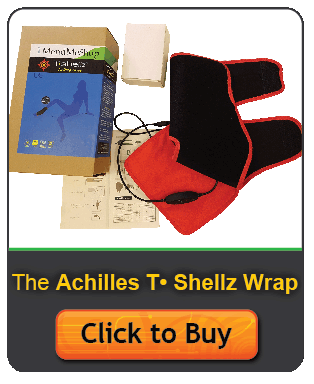
When heat is applied to the achilles and ankle, veins and blood vessels start to get bigger (expand) to allow more blood flow through to your damaged or torn soft tissue. This in turn relaxes the area, making the tissue more flexible and elastic. This is why heat is used on older (chronic) injuries - to loosen soft tissue and bring in the blood flow needed for your soft tissue to repair. Your body will begin to heal itself after it is injured - increasing your blood flow with heat will actually speed up this natural process.
Doctors usually call this process 'Vasodilation'.
Heat can Make Inflammation, Swelling and Newer Injuries Worse - How?
When we injure ourselves, we start healing right away. The body will naturally raise the temperature at the site of the injury resulting in the inflammatory response (redness, heat sensation, inflammation and swelling). This 'fake fever' leaks blood flow to the area to cool it down and start the healing process.
Adding 'heat' to the injured tissue in your achilles when it's already inflamed and tender may make your body think there's a new threat to your tissue and increase the pain in order to get you to stop. For some people applying heat on inflamed / swollen tissue will cause the injury to swell-up even more (as much as 3 times larger than normal). You'll feel even more pain as the pressure builds in your ankle.
Heat is NOT a good treatment method for inflamed soft tissue injuries, new injuries (within the first 24 to 72 hours), right after surgery or right after a re-injury (over-use and/or sharp, throbbing pain). In these cases, heat should be applied later on in the healing cycle, once swelling has reduced substantially. In the meantime, use a Cold Compress or Ice Pack to decrease any inflammation induced pain.
When To Use Heat to Help Your Achilles
The primary intent of a heat based soft tissue treatment is to increase blood flow circulation and, as such, stimulate healing for older (chronic) injuries, recent (acute) injuries and for long-term post surgery recovery. Warmer temperatures should be used approximately 3 to 5 days after you first have the injury. Heat should not be started for a least 6 weeks after surgery (on approval from your physician) as inflammation levels will be very high as the healing process starts over again. Any use of heat should also be combined with gradual movement to stretch out your hamstring and increase range of motion.
If you have a chronic achilles tendon injury that keeps getting re-injured you should use heat before activity to loosen up your tissue (making it more flexible). When used at this time the warm temperatures naturally extend the elasticity of the soft tissue in your tendon, making it more movable / pliable for activity.
Sometimes we feel pain while doing a certain activity - should you still use heat? Using heat in the morning before you start your day or before activity can help to boost the healing process and reduce your risk of re-injury. Too much heat (especially when you suffer a set-back with swelling / inflammation) can make your inflammation worse. A cold compress should be used part-way through your day when you suffer from on-going pain and inflammation - it is a natural pain-reliever.
Using heat is a good long-term plan because can also be used on a preventive basis to relax constricted soft tissue. Heat will speed up blood circulation. This in turn brings all the components your body needs to heal more efficiently - oxygen, nutrients and energy.
Here Are A Couple More Examples For When To Use Cold (Ice) Or Heat:
You've previously suffered from a strain in your achilles tendon
Now you're trying to bring your vaccum cleaner up a set of stairs in your house to clean your bedroom. You forgot about your injury but realize it's there when you try carry, push or pull the vacuum up the stairs with you... Flexing and putting weight on your Achilles tendon just reminded you of the strain, and now you feel a dull ache in the back of your ankle.
Use a Cold Compress or Ice Pack if you see signs of swelling. Once swelling and redness disappear (usually within 48 hrs) use an Achilles TShellz Wrap 2 to 3 times per day - especially just when you get out of bed to help keep your calf and achilles flexible and limber. This will help reduce the risk of further re-injury.
You had achilles tendonitis 2 years ago but you haven't felt pain from that old injury for over a year
You just went to a new fitness / aerobics class and notice your ankle and achilles feel stiff the day after your first class. There's no pain, inflammation or swelling, just stiffness / soreness where your old injury was.
You should use HEAT on your achilles before you work out to loosen up your tendon tissue. Heat can be used again the next day if you notice any residual stiffness. If the stiffness remains, you should continue to use heat to make sure your old achilles tendonitis injury doesn't get worse.
Our Achilles Tendon Formula Works!
It may seem hard to believe, but our Achilles TShellz Wraps® will assist you in recovering from your injury by reducing your swelling and inflammation induced pain, maximizing localized blood flow, and increasing the flexibility / range of motion in the area.
Here at AidMyAchilles we pride ourselves in helping you with your healing and recovery process. Everyone at AidMyAchilles has tested and used the products, finding solutions to conditions that do not fit into the norm. This dedication to our customers and our products goes hand-in-hand with our guarantees to you as a customer:
- Guarantee #1 - Use your products diligently for up to 60 days and you will experience a significant reduction in pain. If not, I encourage you to call us to send back the items for a 100% refund.
- Guarantee #2 - You will not be left in the dark after purchasing any product from us. AidMyAchilles Advisers and Product Specialists are available 5 days a week by toll free phone 1-866-237-9608 or email to answer your questions or concerns.
- Guarantee #3 - Your order is guaranteed to be shipped within 24 hours on every business day.
- Guarantee #4 - All purchases receive a one year, full replacement warranty with guaranteed, prompt service.
- Guarantee #5 - You could save hundreds of dollars and possibly more, by utilizing our products, and getting back to work sooner.
Learn More About Achilles Injuries & TreatmentsI want to learn more about Achilles Surgery & Post-Surgery Recovery I want to learn more about Circulation Boost I want to learn more about Ice & Heat: Which Is Better For The Achilles? I want to learn more about Stretching for the Achilles
FREE SHIPPING ON ALL PRODUCTS CURRENTLY ENABLED
60 DAY TRIAL PERIOD
During your recovery, you will probably have to modify and/or eliminate any activities that cause pain or discomfort at the location of your soft tissue injury until the pain and inflammation settle. The more diligent you are with your treatment and rehabilitation, the faster you will see successful results!
| 

